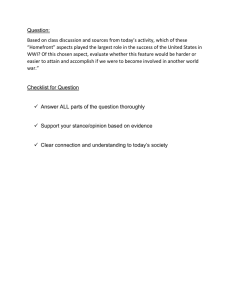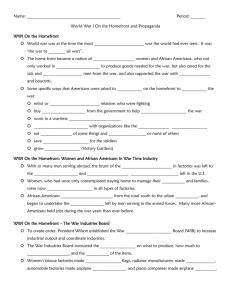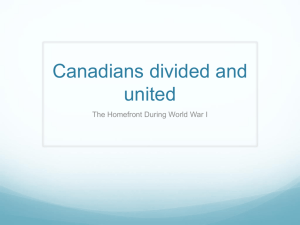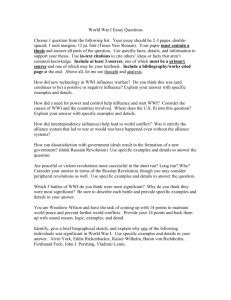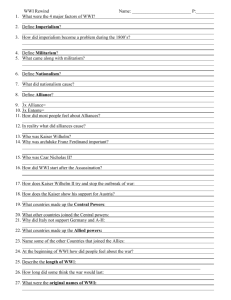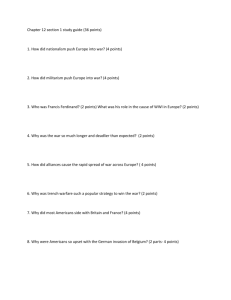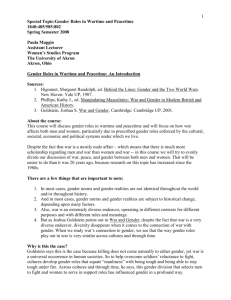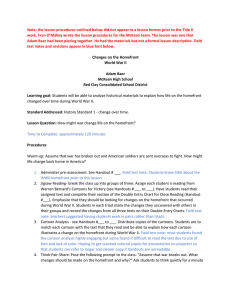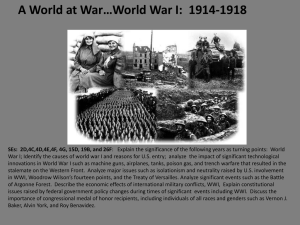Total War on the Homefront
advertisement
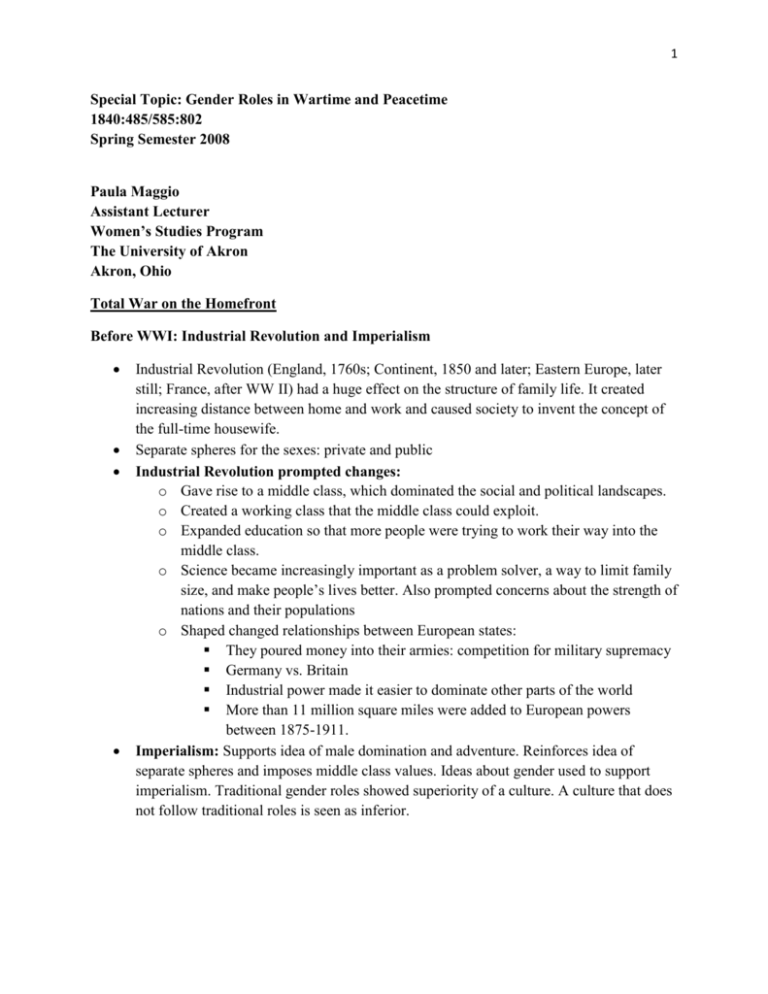
1 Special Topic: Gender Roles in Wartime and Peacetime 1840:485/585:802 Spring Semester 2008 Paula Maggio Assistant Lecturer Women’s Studies Program The University of Akron Akron, Ohio Total War on the Homefront Before WWI: Industrial Revolution and Imperialism Industrial Revolution (England, 1760s; Continent, 1850 and later; Eastern Europe, later still; France, after WW II) had a huge effect on the structure of family life. It created increasing distance between home and work and caused society to invent the concept of the full-time housewife. Separate spheres for the sexes: private and public Industrial Revolution prompted changes: o Gave rise to a middle class, which dominated the social and political landscapes. o Created a working class that the middle class could exploit. o Expanded education so that more people were trying to work their way into the middle class. o Science became increasingly important as a problem solver, a way to limit family size, and make people’s lives better. Also prompted concerns about the strength of nations and their populations o Shaped changed relationships between European states: They poured money into their armies: competition for military supremacy Germany vs. Britain Industrial power made it easier to dominate other parts of the world More than 11 million square miles were added to European powers between 1875-1911. Imperialism: Supports idea of male domination and adventure. Reinforces idea of separate spheres and imposes middle class values. Ideas about gender used to support imperialism. Traditional gender roles showed superiority of a culture. A culture that does not follow traditional roles is seen as inferior. 2 WW I on the Homefront Women’s experiences of war contrast with official versions. Women’s experiences are the domestic, private version, while the official version speaks about the national, public side of war. Society reinforced a separation between what men and women did, between homefront and battlefront. Fears about gender related to male strength and masculinity. WWI was expected to be a quick, successful war that would set things straight. How WWI changed the social environment for women: They could go out un-chaperoned They could work alongside men They could live alone on their own wages They could travel alone, take a hotel room Clothing became shorter, looser, more practical Corsets disappeared; bras invented Women at work in WWI: Women were a huge part of the workforce in WWI It became more common for middle class women to take jobs. They moved into different kinds of jobs. War took women from domestic service or feminized segments of the economy and put them in wartime jobs. In Germany, 38% of the workforce in the Krups Arms Factory were women In France, ½ million women entered the industrial workforce In the U.S., there were 1.4 million women working in the war industry in 1918. In England, the number of women working in transportation went from 18K to 117K; in banking, 9,500 to 63,700; in commerce, 505K to 934K Women at home in WWI: Shortages of food and goods, long lines for food Inflation: in Germany value of mark cut in half Black-market prices Widows, orphans. In Germany, there were 2 widows out of every 9 married women. During the war and right after the war, German pensions were insufficient for even urgent necessities. Women’s expectations: Suffrage movement put on hold. Thought that women would be rewarded with the vote if they performed admirably in the war. 3 That happened for English and German women, but French women did not get the vote until after WWII. For the most part, women were still excluded from politics. Men’s reactions to changes on the homefront: Tremendous fear of women’s infidelity Example: “The ‘Child of the Barbarian’: Rape, Race and Nationalism in France During the First World War” by Ruth Harris Discussion Question: How does this article illustrate men’s fears about women’s infidelity, as well as their own masculinity? Changes were difficult for men to handle when they came home Big difference between homefront and fighting front in every European country due to the fact that men did not understand the hardships the homefront was experiencing State concerns: Supporting the war effort was main concern. Keeping everyone working and keeping everyone docile with propaganda Example: “Food Scarcity and the Empowerment of the Female Consumer in WWI Berlin” by Belinda Davis. Discussion Question: What examples does the BD article give that illustrate the German government’s efforts to keep the populace docile? Separation allowances instituted for women whose husbands or sons were fighting. After the war: The experience of war is disorderly, including sexual disorder/gender roles. When war is over and peace is declared, societies revert to traditional gender roles and relationships. There was backlash everywhere. In France, for example, in 1906, 34.3% of industrial workers were women. In 1926, 28.6%. In 1906, 37.2% of women worked outside the home. In 1926, the figure was 36.4%. Though soldiers had longed for home, hearth, and family during their years in the trenches, many soldiers had trouble fitting into a peacetime environment. They missed the comraderie of their fellow soldiers. Many widows and orphans. In Germany, there were 2.4 million dead soldiers. This left 1.6 million financial dependents, including 371,795 widows and more than 1 million orphans. Schedule: 1. Lecture 2. Student Discussion Questions 4 3. Role Play: a. Women at Work on the Homefront: Munitions Worker b. Women at Work on the Battlefront: Nurse 4. Video 5. For next week: Bring thesis statement and outline to class for work session on research paper
